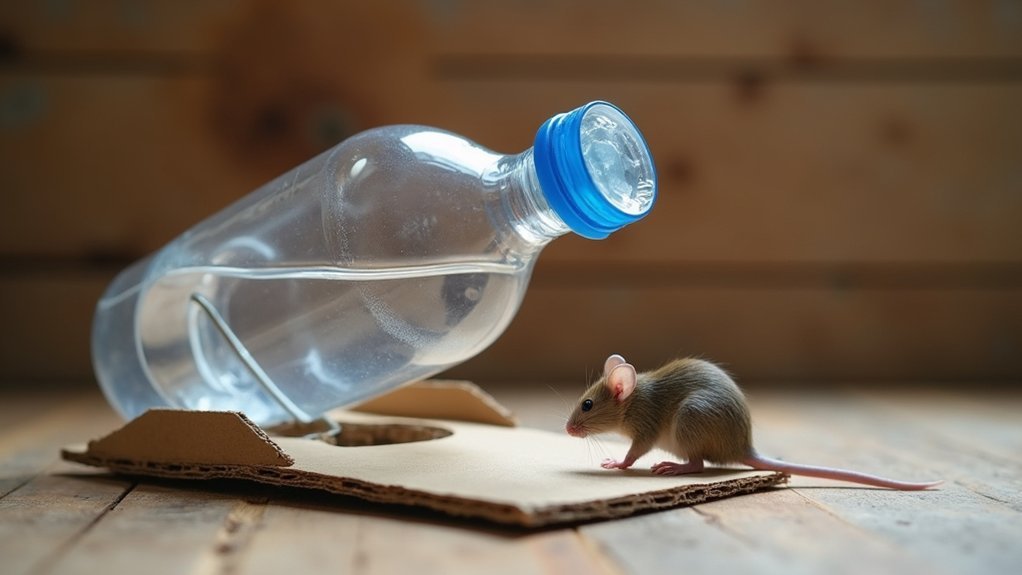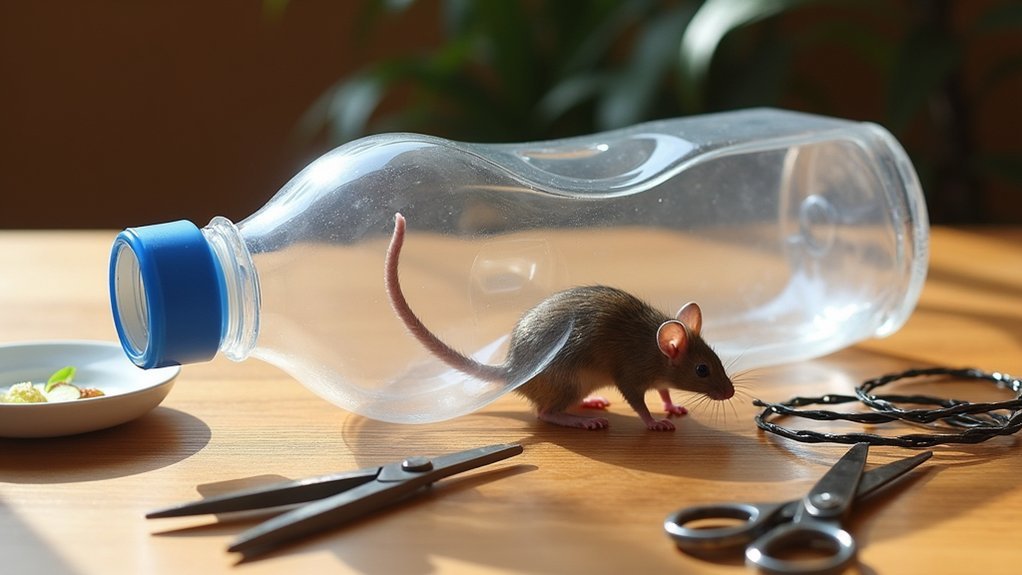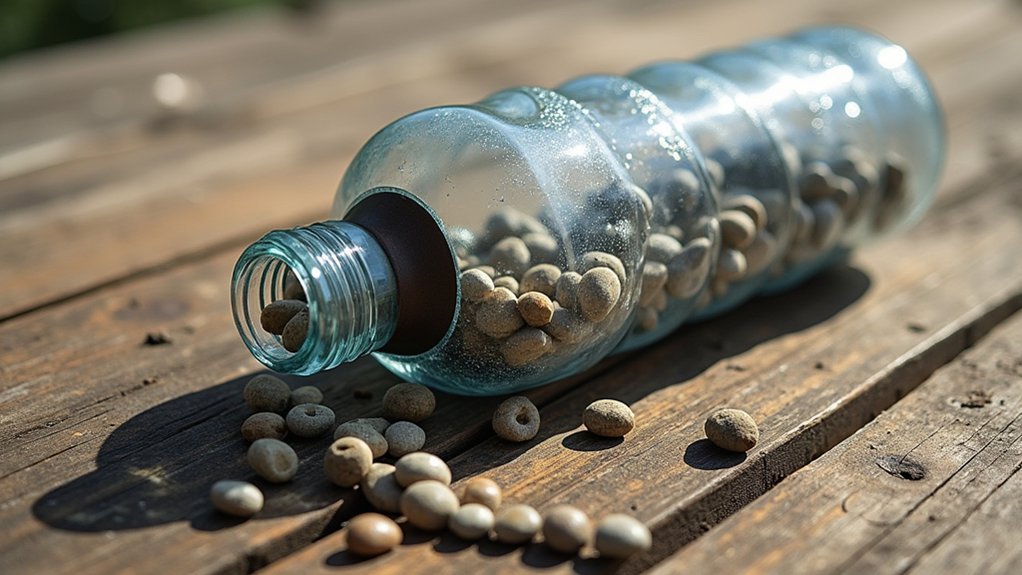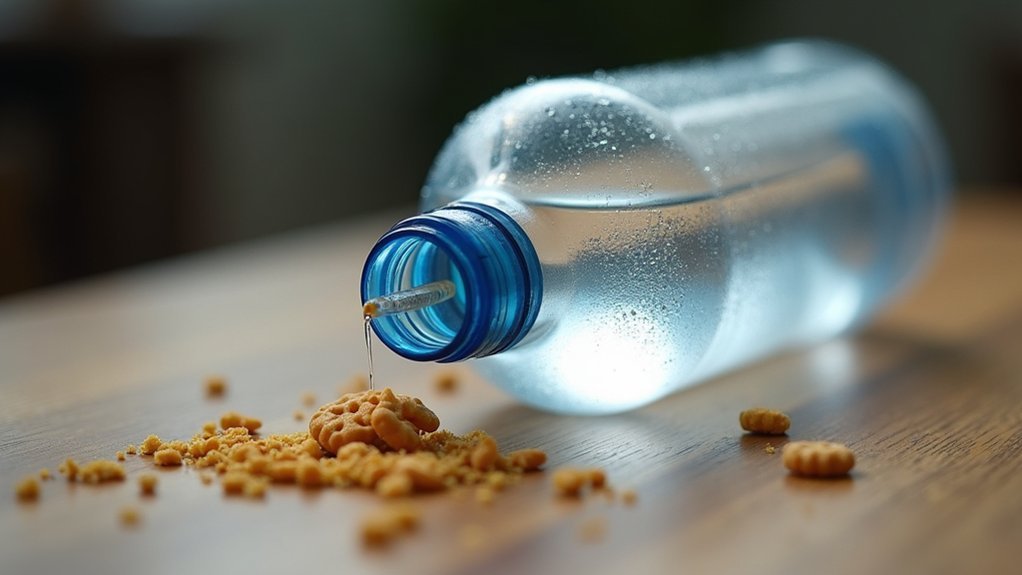Water bottle mouse traps work through clever engineering that exploits rodent behavior. You’ll create a one-way funnel entrance that mice can easily enter but can’t escape from due to inward-pointing edges or a smooth interior. Bait like peanut butter or chocolate draws them in, while the trap’s design prevents their exit. These DIY solutions capture multiple mice effectively while costing considerably less than commercial options. Proper placement and construction techniques dramatically increase your success rate.
Second-Level Headings for “What Makes Water Bottle Mouse Traps Work?”

When examining what makes water bottle mouse traps so effective, you’ll find the answer lies in their clever engineering. These DIY mouse traps utilize a funnel design that permits easy entry while preventing escape through strategically placed spikes or one-way mechanisms.
Your water bottle trap’s success depends on three key elements: proper construction, strategic bait placement, and multiple-capture capability. By recycling plastic bottles, you’re creating an eco-friendly solution that’s also budget-friendly.
The trap’s effectiveness hinges on clean cuts and secure assembly to maintain structural integrity.
What’s particularly impressive is how a single well-designed water bottle trap can catch multiple mice in one night, making it ideal for addressing serious rodent problems efficiently without constant reset or replacement.
The Science Behind Rodent Capture Methods
Understanding the behavioral patterns of mice reveals why water bottle traps succeed where other methods fail. Mice are naturally curious creatures with predictable foraging behaviors that professional rodent control experts exploit.
When you design a bottle trap with a one-way funnel entry, you’re working with—not against—these instincts. The funnel design creates an illusion of safety that appeals to a mouse’s exploratory nature.
Once inside, the non-return mechanisms prevent escape, utilizing the same behavioral tendencies that led them in. Mouse traps that incorporate strategically placed bait deep within the container capitalize on their persistent foraging drive.
The ingenious trap design exploits a mouse’s own curiosity, turning their natural foraging behavior into the perfect capture mechanism.
Unlike complex commercial options, these simple traps are effective because they align with natural rodent behavior while offering an environmentally friendly alternative to chemical solutions or snap traps.
Essential Materials for a Successful Water Bottle Trap

Building an effective rodent trap doesn’t require expensive materials or specialized equipment.
You’ll need a plastic bottle (at least 1.25L) as your primary component, providing ample space to capture mice while ensuring they can’t escape once inside.
You’ll also require basic cutting tools—scissors and a craft knife—to make precise cuts when creating the trap’s funnel mechanism.
Don’t forget tape, which is essential for securing the funnel to the bottle’s base section, eliminating potential escape routes.
The beauty of this DIY trap lies in its simplicity.
With basic crafting skills and recycled materials, you’re not only creating an economical solution to your rodent problem but also contributing to environmental sustainability by repurposing plastic waste into a functional mouse trap.
Step-by-Step Assembly Process
Begin your bottle trap assembly by thoroughly cleaning the plastic bottle and cutting it into two parts—the funnel and catchment sections.
You’ll need to create a stable wooden T-shaped base and drill strategic holes to insert the coat hanger wire that secures the bottle components together.
Before adding bait, test your assembled trap mechanism to verify it functions properly and stands upright, increasing your chances of successfully capturing mice.
Bottle Preparation Steps
Five simple steps transform an ordinary plastic bottle into an effective mouse trap.
Start by thoroughly cleaning your bottle to remove any odors that might deter mice from entering. Even professional exterminators recognize that cleanliness is essential for successful trapping.
Next, cut the bottle into two main sections: first make a cut about one inch below the threaded neck, then make another cut two inches down to create your funnel and base components.
Insert the funnel section into the bottom portion, ensuring it fits snugly to prevent escapes. Secure the edges with tape for stability.
Before adding bait, test your trap mechanism to confirm it works properly. The funnel should allow mice to enter but make it difficult for them to exit.
Mechanism Assembly Tips
Assembling the mechanism for your water bottle mouse trap requires attention to small details that make a big difference in effectiveness. The trap involves creating a well-balanced system using common household items. First, construct your T-shaped wooden base for stability, guaranteeing the bottle will remain stationary during mouse control operations.
| Step | Component | Assembly Tip |
|---|---|---|
| 1 | Coat Hanger | Bend carefully to create proper trigger tension |
| 2 | Drill Holes | Position precisely for proper wire placement |
| 3 | Test Mechanism | Check sensitivity before baiting to guarantee success |
Next, thread your bent coat hanger through the drilled holes in the bottle. This creates the triggering mechanism that will activate when a mouse enters. Always test your trap multiple times before baiting to confirm it’s functioning properly and has the right sensitivity.
Creating an Effective One-Way Entry System

The heart of a successful water bottle mouse trap lies in its one-way entry system, which allows mice to enter but prevents their escape.
The ingenious secret of water bottle traps is their clever one-way entrance—welcoming mice in while ensuring they cannot find their way out.
To create an effective rodent barrier, you’ll need to transform the funnel section into a one-way gate by:
- Cutting 1-inch slices down the funnel section, creating flexible entry points
- Making diagonal cuts to form inward-angled spikes that deter mice from climbing back out
- Installing the funnel properly in your bottle, guaranteeing no gaps exist where rodents might escape
When assembling, make certain the spikes point inward to increase capture effectiveness.
These sharp, angled barriers confuse mice attempting to exit while still allowing easy entry. If you’re unsure about your design, referencing pictures can help you verify your trap has been constructed correctly for maximum performance.
Best Baits to Attract Mice and Rats
Once your trap’s entry system is properly constructed, you’ll need the right bait to entice unwanted visitors inside.
Peanut butter consistently ranks as the most effective option due to its strong aroma and sticky texture that prevents rodents from grabbing and running. Unlike professional pest control services that use specialized formulations, your homemade trap can rely on kitchen staples.
While cheese works occasionally, many mice actually prefer sweeter alternatives. Chocolate provides a powerful scent trail that quickly lures rodents to your trap.
For sustained attraction, consider using seeds and nuts, particularly sunflower seeds or almonds, which mice find irresistible as high-energy food sources.
If you’re targeting rats specifically, rotting fruit like bananas or apples can be particularly effective due to their intense sweetness and smell.
Strategic Placement for Maximum Effectiveness

For your water bottle mouse trap to work effectively, proper placement makes all the difference between success and failure. Position your traps along walls where mice typically travel, ensuring the open end faces the wall to create natural entry points mice will investigate.
Look for these key indicators when determining strategic placement:
- Visible signs of activity like droppings or gnaw marks
- Areas near food sources or suspected nesting locations
- Corners and wall junctions where mice frequently travel
Deploy multiple traps simultaneously in different locations to increase your chances of success.
Setting multiple traps in various spots dramatically improves your odds of catching mice quickly and effectively.
As you observe rodent behavior, don’t hesitate to adjust placement. Remember that mice prefer traveling along edges for safety, so proper positioning along these pathways greatly improves your trap’s effectiveness.
Why Mice Can’t Escape These Simple Traps
Despite their apparent simplicity, water bottle mouse traps create a nearly perfect one-way system that confounds even the cleverest rodents. Once a mouse enters through the funnel-shaped entrance, several design elements prevent its escape.
The diagonal spikes that point inward allow easy entry but block the exit path, while the smooth plastic interior offers no foothold for climbing out. You’ll find that even multiple mice can enter the trap, but none can navigate back through the narrow funnel opening.
This homemade mouse solution works because of physics, not complex mechanisms. When you secure the funnel with tape around the rim, you’re creating an even more formidable barrier.
The slippery bottle surface further frustrates escape attempts, turning a simple recycled container into an effective capture device.
Comparing Water Bottle Traps to Commercial Options

You’ll find water bottle traps cost considerably less than commercial options while often matching or exceeding their effectiveness at capturing multiple rodents.
These homemade traps can be reused indefinitely with simple cleaning, unlike many store-bought versions that require replacement after several uses.
The customizable nature of water bottle traps also allows you to adapt them to your specific situation, making them potentially more effective than one-size-fits-all commercial alternatives.
Cost vs. Effectiveness
When considering your options for mouse control, the balance between cost and effectiveness becomes a crucial factor in decision-making.
Water bottle traps made from household items offer significant savings compared to commercial alternatives that can cost $10-$30, but this cost difference comes with tradeoffs.
Here’s how they compare:
- Investment – DIY traps require virtually no financial investment, using recycled materials you already have, while commercial traps demand upfront costs but offer engineered reliability.
- Efficiency – Homemade solutions work well for minor infestations, but commercial traps typically capture multiple rodents more consistently.
- Humane Considerations – Water bottle traps allow for catch-and-release approaches, potentially saving you disposal costs associated with lethal commercial options.
Your choice ultimately depends on the severity of your infestation and budget constraints.
Reusability Benefits
The environmental impact of mouse control methods extends far beyond their immediate effectiveness. When you choose water bottle mouse traps, you’re selecting a solution that dramatically reduces waste compared to single-use commercial options.
These ingenious traps transform recycled materials into reusable tools that can be cleaned, reset, and deployed repeatedly without additional expense. Unlike commercial traps that often require constant replacement or contain harmful chemicals, your water bottle trap provides a sustainable alternative that’s both eco-friendly and budget-conscious.
You can easily adapt a small box and bottle combination to target specific rodent problems in your home. The versatility of these DIY solutions means you’ll save money while reducing your environmental footprint—a perfect combination of practical reusability benefits that commercial traps simply can’t match.
Humane Handling and Disposal Considerations
Capturing mice humanely is only half the solution; proper handling and disposal practices complete the ethical approach to rodent management.
Once you’ve trapped rats and mice, you’ll need to decide whether to release or dispose of them. Careful humane handling minimizes stress to the animal while you determine its fate.
Follow these steps for proper handling and disposal:
- Carefully transport the trap to avoid causing stress or injury to the captured mouse.
- Release the mouse at least one mile from your home to prevent it from returning.
- If release isn’t possible, consider submersion in water as a humane disposal method that minimizes suffering.
This approach not only addresses your rodent problem but also promotes sustainability by repurposing plastic bottles while maintaining ethical treatment of these creatures.
Common Troubleshooting for Failed Captures
Despite implementing responsible disposal practices, you may encounter moments when your water bottle trap fails to catch any mice. If you feel the need to enhance your trap’s effectiveness, first examine its placement.
Position traps along walls and corners where mice frequently travel.
Place your traps strategically along walls and in corners where mouse traffic is highest for maximum effectiveness.
Place bait deep inside the bottle, not near the entrance. Mice won’t fully enter if food is easily accessible from outside.
Guarantee your trap is stable—wobbly contraptions spook cautious rodents.
Inspect the bottle for jagged edges that might deter mice. Smooth out any sharp cuts around the entrance that could cause injury or hesitation.
After each capture, thoroughly clean your trap. Mice are surprisingly sensitive to scents, and residual odors from previous catches may prevent new mice from entering.
Frequently Asked Questions
Why Are Mice Not Getting Caught in Traps?
Your mice aren’t getting caught because you’ve placed bait improperly, used poorly constructed traps, positioned them incorrectly, chosen ineffective bait, or you’re dealing with too many mice for your traps to handle effectively.
How Do Plastic Mouse Traps Work?
Plastic mouse traps work by enticing mice with bait placed inside a cleverly designed container. You’ll find they use one-way entrances that let mice in easily but prevent their escape through angled barriers or mechanisms.
What Attracts Mice to Traps the Most?
You’ll attract mice most effectively with strong-smelling foods like peanut butter, chocolate, and seeds. Place these baits along walls where mice travel. Their natural curiosity and hunger will draw them to your traps.
What Is the Number One Killer to Mice?
Predation is the number one killer of mice. You’ll find cats, owls, and snakes regularly hunt them in the wild. Disease follows closely, with pathogens spreading rapidly in mouse populations due to their social nature.
In Summary
You’ve now learned how water bottle mouse traps use simple physics to create an effective one-way system that mice can’t escape from. With household materials and proper setup, you’ll catch rodents humanely and inexpensively. Remember to check your trap regularly and release captured mice far from your home. While not as immediate as snap traps, these DIY solutions offer a practical alternative that’s both economical and surprisingly effective.





Leave a Reply